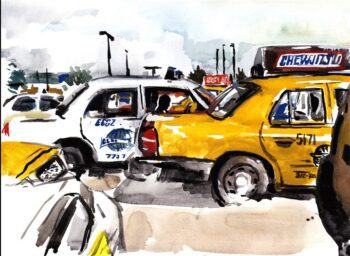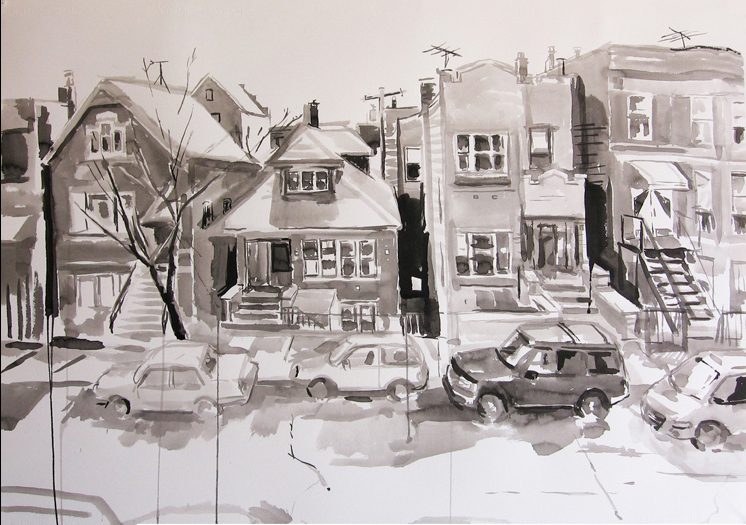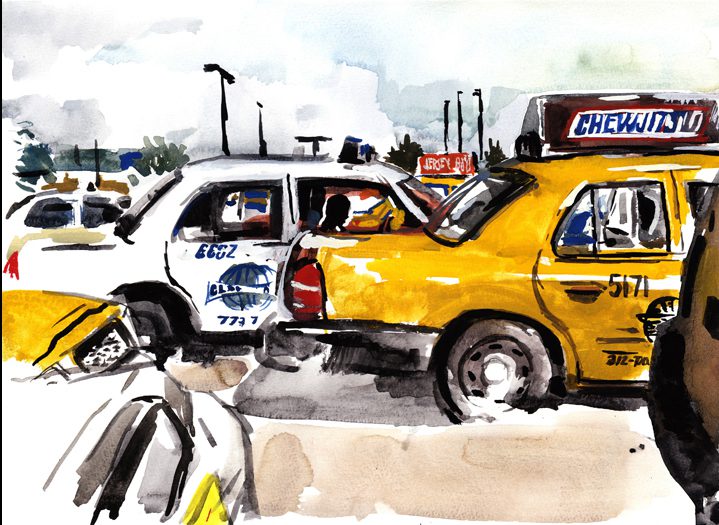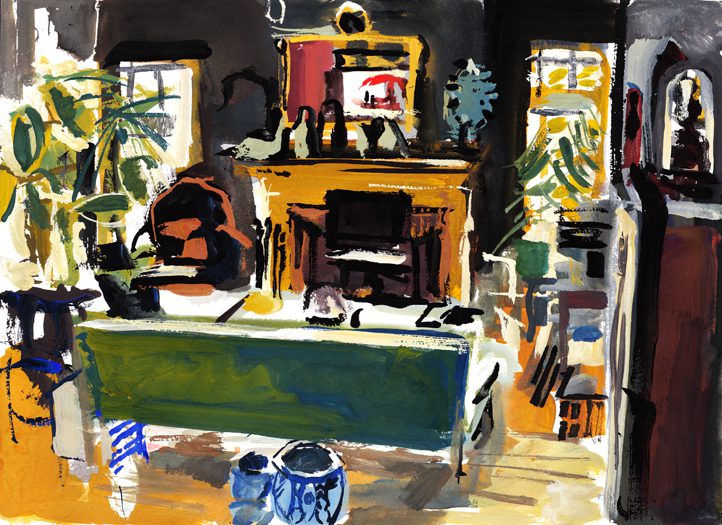
I met Dmitry Samarov on Twitter, probably through a re-tweet of one of his musician pals I follow. At the time, he was a cab driver in Chicago, watching the world through his windshield and bulletproof glass, and recording his observations through essays and drawings.
After seeing a piece or two, I did some heavy Internet stalking. I was floored. Dmitry’s spontaneous cab drawings had such great composition and confidence. You could almost feel his grimace in so many of his lines. And his more thought-out cab paintings managed to maintain that moment. I’m not sure if the text he writes accompanies the drawings or the drawings accompany the text—but they work so well together, only a fool would ask. His oil paintings of books and apartment interiors and exteriors were a de Kooking/Giorgio Morandi/Philip Guston gang-bang—and they were beautiful. They are beautiful.
And he’s made so. Much. Work.
In addition to his painting and drawing, Dmitry published a book in 2011 called Hack. A few months ago, he successfully completed a Kickstarter to quit driving a cab and draw and write full-time. And he’s now working on a second book.
Dmitry Samarov: Nope. I was born in the Soviet Union and my family moved to the Boston area when I was seven. I first got to Chicago in 1990 to attend the School of the Art Institute of Chicago. I’d spent my first semester of college at Parsons in New York and hated it so much, I transferred to SAIC after just half a year. I moved away after graduating in 1993, but moved back in 1997 and have been here ever since.
All in all, I’d certainly say that Chicago is as close to a place I could call home as I’ve ever had.
Rumpus: How did you start making art?
Samarov: I don’t remember ever not doing it. It’s always been my primary way of dealing with the world.
Rumpus: For years you wrote and drew about your experiences as a cab driver. How did that come about?
Samarov: I started driving a cab in Boston in 1993, right after graduating from art school. I needed a job and knew my BFA just about qualified me for a service industry gig. One day, looking through the want-ads, I saw a “Drivers Wanted” ad and followed it to Checker Taxi of Boston on St. Botolph Street. A couple weeks later (after taking some very rudimentary classes), I became a cab driver.
There was a lot of downtime in the cab waiting on hotel cab stands and out at the airport, so I started drawing self-portraits in the rearview mirror, and the view of the city out the cab’s windows. I never had any grander plans for these drawings, it was just a way to record where I was spending my nights. When I started driving again in Chicago, I had already self-published the first version of Hack, so I probably knew that the artwork I’d do in the cab would be part of some larger project.
Ultimately, though, the reason I painted and drew in the cab is that my artwork has always come from the outside world, and if that outside world for sixty to eighty hours a week is in and around a taxi, then that’s what the pictures will be of. There was just no way around it.
Rumpus: What’s your process with this work? Did you paint onsite, or from photos or memory?
Samarov: All the paintings and drawings of cabs like these were done on the spot, in whatever time was available, whereas most of the pictures of cab customers, as well as many of the other illustrations for the Hack stories, were done from memory. I wish I could’ve pulled the cab over and had some of the passengers pose for me, but that didn’t happen much. My first choice is always to work from life, but that isn’t always possible.
Rumpus: Did painting and writing about the people you observed change your relationship with them? Did you know any of them?
Samarov: I never started conversations with passengers. I’d ask, “Where to?” and then keep quiet, unless they wanted to talk. I don’t know that writing about them changed things much. I’ve always been a watcher and listener, first and foremost; the cab just gave me a different, more intimate venue to do what I’ve always done.
I didn’t ever draw passengers that I didn’t already know. I did form some friendships with passengers, though, and, sometimes, they would pose for portraits, but not in the context of the cab. The stories and pictures in the cab depended on a certain level of anonymity and non-interaction with the subjects. I needed a distance from them in order to see and portray them truthfully and clearly.
Rumpus: How long did you drive a cab for? How did your writing and artwork change over time?
Samarov: I drove for twelve years in all: three in Boston and nine in Chicago. I know the writing changed a lot over that time. I never had any ambition to write before finding myself behind the wheel and being bombarded by stories. By the time my book came out in 2011, I could almost call myself a writer without being embarrassed.
As to the artwork, it’s harder to say, but I think that the time I put in painting out the cab’s windows couldn’t have hurt. Prior to driving a cab my work was much more centered on interiors, on rooms, be it my own apartment or the coffee shop or bar where I was spending my days or nights. Driving around the city made me much more interested in painting the city. I’ve never really been much interested in nature, but the built environment is an endless fascination to me.
Rumpus: How did your book Hack come about? (And an aside: why is it called Hack?)
Samarov: It’s called Hack because that was an old term for a cab driver. In Boston, the license to drive a cab was called a Hackney Carriage license. Of course the other meanings of the word are a great added bonus (especially for a piece of writing). I made a zine called Hack in 2000, to tell about my time behind the wheel in Boston. I revived it as a blog a few years after starting to drive again here in Chicago. I never had any plan for it to become a book, but the longer it went, the more it became clear that it was adding up to something. Levi Stahl at University of Chicago Press became a fan of my writing and pitched it to them as a book. Hack: Stories from a Chicago Cab was published in October, 2011.
I’m now working on a second book: more illustrated stories from behind the wheel. I go a bit deeper into the inner-workings of the cab industry, as well as the reasons why I got into the cab racket to begin with. It covers from 1993 (when I started driving) to 2012 (when I quit). It’s not really a sequel to the first book, but rather another take on similar subject matter through a wider, clearer lens than was available to me for the first one.
I’m waiting on a couple publishers to get back to me, but I hope to have it out sometime in 2014.
Rumpus: Speaking of books, you also have a really different body of work: you make these incredibly lush oil paintings of your bookshelves—messy stacks, goops of paper building up and falling across the canvas. It seems like you’ve done tons of them—all variations on the theme. What attracts you to the subject matter?
Samarov: I’ve been painting pictures of my bookshelf for about fifteen years now. What I like about it is that it’s always changing. Books, magazines, postcards, etc. are taken out and replaced with others over time, so it never stays the same. Every time I start a new picture, it’s of a different bookshelf in a way. It solved a problem I always had with painting still-lifes. I always hated setting them up; it felt like homework and like I was stage-managing a “scene,” whereas I’ve always been more interested in catching what’s already out there. I also find it funny to paint the outsides of books when everything a book is is contained between their covers and in no way visible in a painting.
Rumpus: And the paintings are in every way—subject, time, medium, smell, repetition, meditation—the complete opposite of the Internet, namely Twitter, which is how you and I met. You have this work that’s about such direct interaction and observation, and often it’s shown to distant strangers on a screen made of light. What role does this play in your your art-making, if any?
Samarov: I was really late to the Internet. I didn’t even know how to turn on a computer ’til sometime in 2003, but very soon after I dove in up to my neck. Once I made my peace with the fact that no matter how I photographed my work, it wouldn’t look anything like it does in person, I was off and running. There’s definitely an irony in the fact that I’ve gotten whatever acclaim or attention I’ve gotten through a virtual medium, when what I do is made of paper and canvas and paint. I have daydreams of unplugging from all these networks one day, but that just isn’t possible yet.
***
Where to see Dmitry’s drawings and paintings:
“Dmitry Samarov: Bookshelf Paintings” is up through March 1st at the Harold Washington Library in Chicago.
“Dmitry Samarov: Paintings & Drawings” is up until mid-March at Atomix Coffee in Chicago.
“Shay DeGrandis: Crushes & Dmitry Samarov: Covers” opened February 22nd at Elastic Arts in Chicago.
Other works online:
Commercial and Editorial Illustration: record covers, travelogs, and sports articles, and work for the The Chicagoan
Commissions: pet portraits, to paintings of bars, to children’s book illustrations
***
All featured artwork © by Dmitry Samarov.
First image: “Stoops,” sumi ink on paper, 32×40 inches, 2008.
Second image: “Staging Area #10,” gouache on paper, 9×13 inches, 2009.
Third image: “Beverly Living Room,” gouache on paper, 9×13 inches, 2010.
Fourth image: “Soutine,” oil on board, 13×14 inches, 2001.








